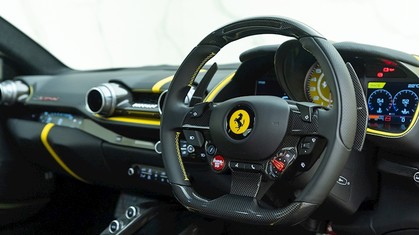Ferrari Turning Back to the Turbo Engine
The downsizing of engines has become common place in the world of automotive and performance cars and now the biggest name of all, Ferrari has addressed this continuing trend in order to meet emission regulations by returning to turbocharged engines. This has recently been demonstrated in the new California T which is set to be go for sale at the end of the year but it has now been revealed that the replacement for the naturally aspirated 458 Italia will also feature a turbocharged engine.
Despite turbocharged engines being renowned for having issues with turbo lag, the reason why Ferrari has reverted back to forced-induction for the first time in over two decades is down to efficiency – the Italian badge, in the company of Audi, Mercedes and Maserati, are having to find ways to cut the level of emissions of their luxury supercars. This reduction has certainly been achieved by the California T, with the turbocharged eight-cylinder engine outperforming its naturally-aspirated alternative; not only does it consume 15 per cent less fuel, the emissions of carbon dioxide also drops from 299 grams per kilometre (g/km) to a pleasant 250.
Ferrari made their intentions to produce efficient supercars very clear with the LaFerrari, the first ever mild-hybrid model created by the marque. While it doesn’t have a turbo, the combination of a 6.3L V12 and an electric motor serves as a window into a sustainable future for the brand. Ferrari dealers has claimed that this sustainable outlook has helped them reduce its average CO2 emissions by a staggering 40 per cent since 2007.
Ferrari claim that the California T can accelerate from 0-62mph in just 3.6 seconds, continuing to eat up the tarmac until topping out at a respectful 196mph – both figures that indicate an enhancement compared to the conventional model.
A Turbo engine free from Turbo lag
A turbo engine works by pumping extra air into the cylinders, enabling the vehicle to benefit from extra power despite a smaller engine. The consequence of this is almost always a sluggish rate of initial acceleration – known more familiarly as turbo lag. However, Ferrari claim that the work by their engineering boffins has enabled the California T to drive completely free of turbo lag. They have also installed an upgraded crankshaft and modified the car’s exhaust to enhance the noise offered; this change is said to make the California T louder than the standard model, despite the latter having the benefit of a naturally-aspirated engine.
This isn’t the first time that Ferrari had turned towards the turbocharged engine, with the last they created being the fabled F40. Arriving back in 1987, it featured a 2.9L twin turbo and was the most powerful, fastest and most expensive car the marque had ever sold to the public at the time.
While supercars will of course continue to stay at the top of the emissions tables, it’s clear that work needs to be done to ensure that they meet the ever tightening rules on emissions. With this in mind, it’s likely that the future of supercars lies firmly within the realm of turbo engines.





